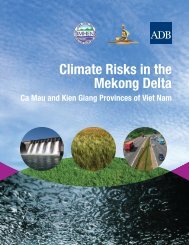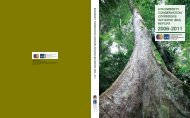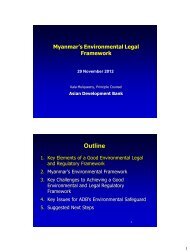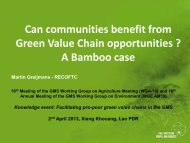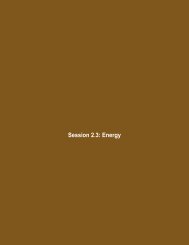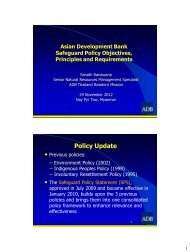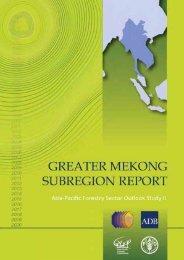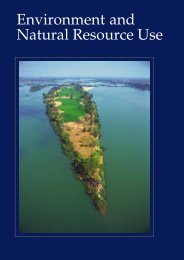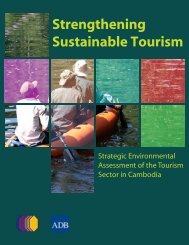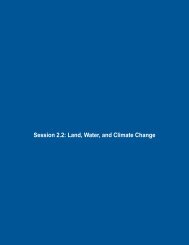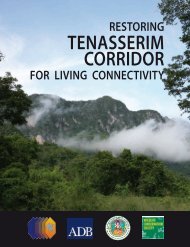Create successful ePaper yourself
Turn your PDF publications into a flip-book with our unique Google optimized e-Paper software.
Protected AreasProtected areas are the primary means ofprotecting biodiversity. The WorldConservation Union (IUCN) defines aprotected area as an area of land and/orsea especially dedicated to the protection andmaintenance of biological diversity, and of naturaland associated cultural resources, and managedthrough legal or other effective means.As defined by IUCN, protection must maintainbiodiversity and natural resources. And it must havean explicit legal or social basis.Sites that combine attraction, recreation, andnature conservation uses can also qualify if at least75% of the area is managed primarily forconservation. Nonconsumptive and low-intensityuses are compatible with some categories within theIUCN scheme, but such sites as forest plantationsmanaged primarily for timber production do notqualify.IUCN categoriesThe IUCN system of classifying protected areas was designed to standardize and facilitatethe collection and dissemination of data and to improve communication amongcountries. Standardization of parks and protected areas in differing ecosystems and indifferent political, legal, and cultural contexts is achieved by using managementobjectives as the basis for comparison. This provides enough flexibility to account for arange of possible combinations of management objectives, socioeconomic contexts, andecosystems. Definitions of the categories, and examples of each, are provided inGuidelines for Protected Area Management Categories (IUCN 1994).CATEGORY Ia.CATEGORY Ib.CATEGORY II.CATEGORY III.CATEGORY IV.CATEGORY V.CATEGORY VI.Strict Nature Reserve: protected area managed mainly for science.Wilderness Area: protected area managed mainly for wildernessprotection.National Park: protected area managed mainly for ecosystemprotection and recreation.Natural Monument: protected area managed mainly forconservation of specific natural features.Habitat/Species Management Area: protected area managed mainlyfor conservation through management intervention.Protected Landscape/Seascape: protected area managed mainly forlandscape/seascape conservation and recreation.Managed Resource Protected Area: protected area managed mainlyfor the sustainable use of natural ecosystems.Three Parallel Rivers of Yunnan Protected Areas—Inscribed as a World Heritage Site in 2003This World Heritage Site consists of eightgeographical clusters of protected areas within theboundaries of the Three Parallel Rivers National Parkin the mountainous northwest of Yunnan Province,PRC. The 1.7-million ha site features sections of theupper reaches of three of the great rivers of Asia:Thanlwin, Mekong, and Yangtze (Jinsha). These riversrun roughly parallel, north to south, through steepgorges that, in places, are 3,000 m deep and arebordered by glaciated peaks more than 6,000 mhigh. Its special features are• outstanding value for displaying the geologicalhistory of the last 50 million years associated withthe collision of the Indian Plate with the EurasianPlate, the closure of the ancient Tethys Sea, and theuplifting of the Himalaya Range and the TibetanPlateau;• dramatic expression of ecological processes—amix of geological, climatic, and topographicaleffects;• outstanding natural features—the deep,parallel gorges of the Jinsha, Lancang (Mekong), andNu Jiang (Thanlwin) are the dominant scenicelements in the area, and high mountains areeverywhere, with the glaciated peaks of the Meili,Baima, and Haba Snow Mountains providing aspectacular scenic skyline; and• location in northwestern Yunnan Province, thearea of richest biodiversity in the PRC and possiblythe most biologically diverse temperate region onearth, encompassing most of the natural habitats inthe Hengduan Mountains, one of the most importantremaining areas for conservation of the earth’sbiodiversity.Source: UNESCO, http://whc.unesco.org/sites/1083.htmEnvironment and Natural Resource Use 83





